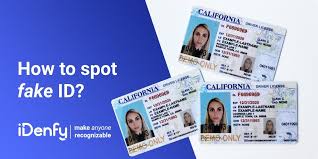How to know if an ID is real online?

How to Know if an ID is Real Online: A Comprehensive Guide
In today's digital world, verifying someone's identity online has become increasingly important. Whether you're hiring remotely, meeting someone through a dating app, or conducting any form of online business, knowing if an ID is real online can protect you from fraud. But how exactly do you determine if an ID is legitimate? This guide will walk you through essential steps to identify and verify IDs online.
Why Verifying an ID Online is Crucial
Online fraud is a growing concern for individuals and businesses alike. Fake identities can lead to financial losses, legal issues, and even personal harm. Verifying IDs online ensures that the person you are dealing with is authentic and trustworthy.
1. Check the Source of the ID
The first step in determining if an ID is real online is to verify where the ID is issued from. IDs issued by official government bodies (such as passports or driver’s licenses) are typically the most secure.
- Government-issued IDs: These are the gold standard for identity verification online. Look for clear indications that the ID is from an official source, such as seals, barcodes, or unique identification numbers.
- Online databases: Some platforms provide tools to verify IDs through official government or third-party databases. For example, websites can access certain public records to match the details provided on an ID.
2. Check for Common Signs of Fake IDs
Understanding the most common signs of fake IDs can help you spot a fraudulent one more easily. Here are some red flags to watch for:
- Low-quality images: A legitimate ID will have a clear and high-resolution photo. If the image looks blurry or manipulated, the ID might be fake.
- Mismatched information: Cross-check all the details on the ID, such as the name, date of birth, and address. If any of this information seems inconsistent or doesn’t match known records, be wary.
- Expired dates: Always check the expiration date. Fake IDs may use an expired ID with altered information.
3. Use ID Verification Tools
For businesses or individuals frequently dealing with IDs, investing in ID verification tools can make the process easier. These tools use advanced algorithms and databases to analyze and verify IDs in real-time.
- Online ID verification services: Companies like Jumio, ID.me, and Onfido specialize in verifying the authenticity of online IDs by checking them against global databases. Using these services can significantly reduce the risk of falling victim to fake identities.
- Facial recognition technology: Some platforms offer biometric authentication, matching the person’s face with the photo on the ID to ensure it belongs to them.
4. Perform a Reverse Image Search
A reverse image search is a powerful tool for verifying whether a photo on an ID has been used elsewhere online. You can upload the photo to Google Images or other reverse image search engines to see if it has been posted on multiple platforms, which could indicate the ID is fake.
- Long-tail keyword: “How to perform a reverse image search for ID verification” is a frequently asked question when it comes to verifying if an ID is real online.
5. Verify the ID Holder’s Information Online
Once you’ve analyzed the ID itself, it’s important to cross-check the holder’s information across different online platforms.
- Social media profiles: Look up the person’s name on platforms like LinkedIn, Facebook, or Instagram to confirm their details match the ID. Inconsistencies in name, age, or location are a red flag.
- Public records search: Many public records databases allow you to verify someone’s identity by looking up their background. You can confirm information such as address history, phone numbers, and more.
6. Contact the Issuing Authority
If you're still unsure about the legitimacy of an ID, contacting the issuing authority is one of the most effective ways to confirm its authenticity. For example, you can reach out to the Department of Motor Vehicles (DMV) or the passport office to verify an ID number.
Conclusion
Knowing how to verify an ID online is crucial in today’s digital landscape, whether you’re managing a business or meeting someone for the first time online. By understanding the basic steps—checking the source, spotting fake IDs, using verification tools, and cross-checking online information—you can protect yourself from fraud. With the rise of identity theft and online scams, making sure an ID is real online should be a priority for anyone operating in the digital world.
Additional FAQs
- How do ID verification tools work? They compare the information on an ID with global databases and use facial recognition to confirm identity.
- Can reverse image searches help in identifying fake IDs? Yes, reverse image searches are effective in determining if a photo has been used in multiple places online.
- Is it safe to share personal ID online? Always be cautious when sharing personal information. Only provide ID to trusted and secure websites.
 Delaware ID Features
Delaware ID Features
 fake ID purchase guide
fake ID purchase guide
 Fake ID Buying Guide
Fake ID Buying Guide
 benefits of fake ID
benefits of fake ID